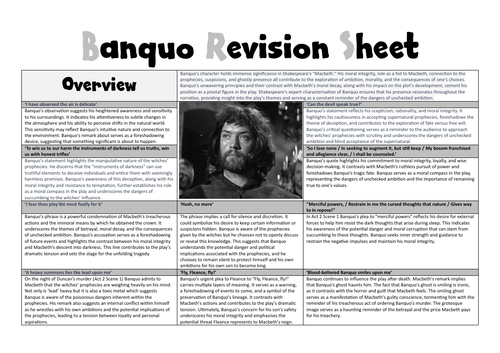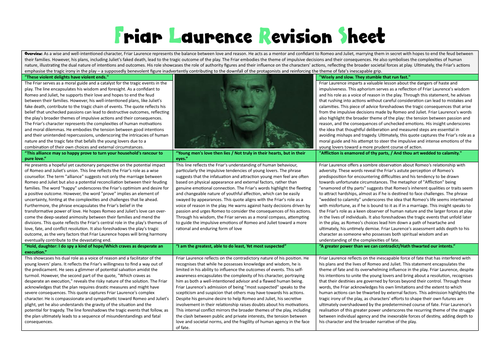321Uploads
64k+Views
38k+Downloads
All resources

Banquo Revision Sheet
A revision sheet analysing 10 key quotations on the character of Banquo in Macbeth. Also contains a blank template version. I will ask students to try and complete this first before giving out the answer sheet.
Comes in editable word format and pdf.
A perfect revision document for this character who may or may not come up in the 2024 exam.

Grade 9 essay on Scrooge's fears
A grade 9 response exploring how Scrooge’s fears are presented in the novella.

Macbeth violent character grade 9 response
An exam-style grade 9 response that would comfortable fit into band 6 that explores how Shakespeare presents Macbeth as an evil/violent character.
I have not included the 2019 question or extract but it is available on the AQA website under assessment materials.
There is perceptive debate with judicious use of quotations and assured analysis of methods and wider ideas.
Also contains a differentiated adaptive writing frame to help lower ability students achieve a grade 4.

Grade 9 response how the ghosts change Scrooge's attitudes and beliefs
A grade 9 response on how the ghosts change Scrooge’s attitudes and beliefs.

Grade 9 Romeo and Juliet's relationship
A grade 9 style response examining how Romeo and Juliet’s relationship is presented.

Feminine Gospels - Annotations
Over 75 slides containing detailed annotations for all the poems in the collection. A useful starting point for helping to develop your own interpretations of the poems within the collection.

The Long Queen - Feminine Gospels
A 28 slide PowerPoint that includes an engaging starter, detailed annotations of each stanza, discussion about the overall message in the poem, comprehension questions, a band 5 sample paragraph and extension tasks involving analytical writing and researching archetypes.
Also includes 5 sample essays ranging from low band 5 down to band 2 answering the following question:
Examine the view that in Feminine Gospels 'women are presented as victims of society.’
Ideal for moderation or looking at looking at how to build up through the bands.
Also contains a revision sheet with analysis of 10 key quotations from the poem on one handy printable sheet.

The Light Gatherer - Feminine Gospels
Lesson looking at The Light Gatherer. Includes an engaging starter, a range of comprehension and exploratory questions, detailed annotations of the poem, high level model paragraphs. Overall, an ideal introduction for teachers who are new to teaching Feminine Gospels.
Also contains a range of essays at bands 2, 3, 4 and 5 exploring the theme of motherhood in the collection.

The Cord - Feminine Gospels
A detailed lesson that is ideal for teachers new to teaching this poem. It includes an engaging starter, line by line annotations of the poem, comprehension questions, a quotation comparison activity, two example high level paragraphs following by an analytical task looking at the theme of motherhood in the collection.

The Handmaid's Tale - Annotations of key extracts - 200+ slides
Over 200 slides with detailed notes, questions and annotations for key extracts and chapters across the novel.

Relationships between adults and children Grade 8 response Romeo and Juliet.
Grade 8 response exploring how Shakespeare presents the relationships between adults and children in Romeo and Juliet.

Suffering of the poor grade 9 A Christmas Carol response
A grade 9 response exploring how Dickens presents the suffering of the poor in A Christmas Carol.

An Inspector Calls 'Because, But, So' thesis-style introductions
The ‘because, but, so’ method is an excellent tool for teaching students to think analytically about the literature texts This tool is powerful because it encourages students to expand their thinking with precision and detail.
This resource collates 9 sample ‘because, but so’ thesis-style introductions to 9 themes that may come up in next year’s An Inspector Calls examination.
It also collates 6 sample ‘because, but, so’ introductions on the 6 main characters in the play.
Ideal as a revision tool for helping to shape and guide the direction of exam responses.

Juliet Grade 9 exemplar
A grade 9 model answer focusing on the character of Juliet.
The model answer starts with a thesis statement.
It moves on to analyse the youthful, idealistic nature of Romeo’s feelings for Romeo early in the play.
The second half of the essay moves on to explore the growing maturity of Juliet’s feelings later in the play.
The word count for the response is 1014 words.
Also includes revision cards for critical perspectives into Romeo’s character to really help push for that grade 9 in A03.

Appositive Phrases for GCSE English literature
Using appositive phrases in your English literature responses will improve the sophistication of your writing. If used correctly, they will impress your examiner. Here are some examples on how to use appositive phrases when writing about the 6 main characters in the following texts:
Macbeth
Romeo and Juliet
A Christmas Carol
An Inspector Calls
Lord of the Flies
Animal Farm

Macbeth 'Because, But, So' Thesis-style introductions
The ‘because, but, so’ method is an excellent tool for teaching students to think analytically about the literature texts. This tool is powerful because it encourages students to expand their thinking with precision and detail.
This resource collates 9 sample ‘because, but so’ thesis-style introductions to 9 themes that may come up in next year’s Macbeth examination.
Ideal as a revision tool for helping to guide the direction of essays.

Macbeth Top 30 Quotations Revision
A 76 slide PowerPoint that systematically goes through 30 key quotations from the play chronologically.
Students are given the quotation and a prompt question to discuss. The next slide offers analysis of the quotation. This process is repeated for all 30 quotations.
The worksheet is used at the end to check how much information students have retained.

Romeo and Juliet 'Because, But, So' Thesis-style character introductions
‘Because, But, So’ a great tool to teach students to help them demonstrate the depth of their understanding of the literature texts.
This resource collates 9 sample ‘because, but, so’ thesis-style introductions for the 9 most significant characters in Romeo and Juliet.

Friar Laurence Revision Sheet
A revision sheet analysing 8 key quotations by Friar Laurence in Romeo and Juliet.

Using Pathetic Fallacy to Describe a Setting for Paper 1 Question 5
When approaching Paper 1 Question 5, I advise students to begin with an opening paragraph that uses pathetic fallacy to describe a setting.
Here are 6 examples that use pathetic fallacy to depict the opening.
They also consistently use ambitious tier 2 vocabulary and advanced punctuation to help show the sophistication required for the top band of the mark scheme.
After studying the 6 model paragraphs, students should then move on to create their own pathetic fallacy opening paragraphs.




















